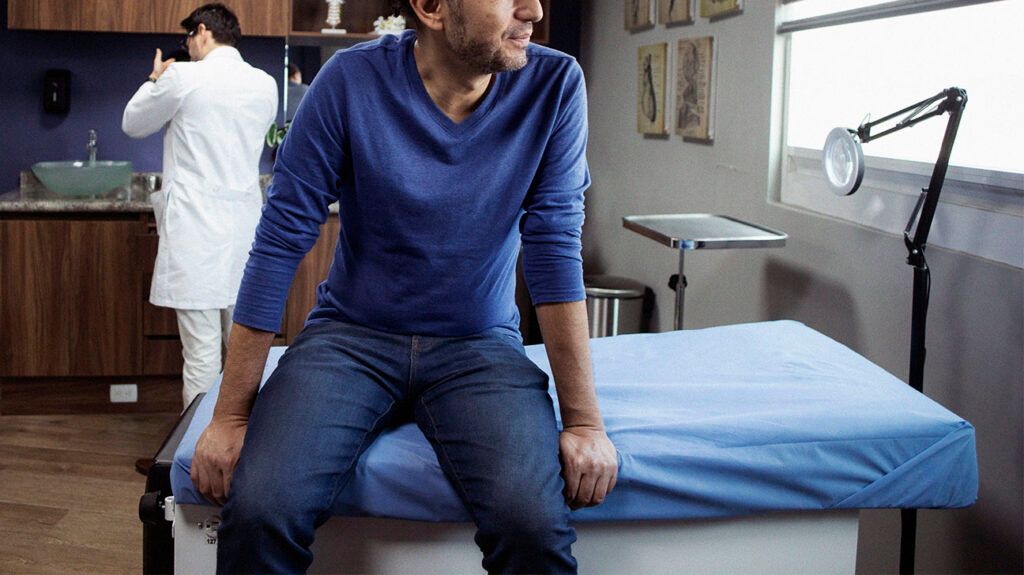Doctors do not typically use a cystoscopy to detect or diagnose prostate cancer, but it may reveal abnormalities in the prostate or signs of cancer in the bladder and other areas of the urinary tract.
Urologists use a cystoscopy to enter the urethra to visualize the bladder, prostate, and other parts of the lower urinary tract in people assigned male at birth. Doctors may recommend a cystoscopy to investigate the source of blood in the urine and other urinary tract symptoms.
Following prostate cancer diagnosis, a urologist may use a cystoscopy to see if the cancer has spread to the bladder. However, they typically use other diagnostic tools, like MRI scans.
Keep reading for more information about what a cystoscopy involves, how doctors diagnose prostate cancer, and some common treatments for the condition.

A cystoscopy involves the use of a small tube, or cystoscope, that a urologist inserts into the opening of the urethra at the tip of the penis.
Healthcare professionals
The cystoscope may be flexible or rigid in structure. The procedure can take place informally in a healthcare professional’s office or in an operating room. A urologist will likely review the location and the reason with a person when recommending the procedure.
The most common reasons for having a cystoscopy include:
- blood in the urine
- surveillance or evaluation of cancer in the bladder, urethra, upper urinary tract, or abnormal cytology
- lower urinary tract symptoms
- trauma following injury
- diagnosing a fistula, which is an abnormal connection forms between structures in the body
- abnormal imaging of the bladder
- blood in semen
- removal of a foreign object
- azoospermia, which is when no sperm appears in the ejaculate
While cystoscopy may help doctors view the prostate and identify some abnormalities, it is not usually used as a screening tool for prostate problems or cancer.
Doctors do not generally recommend cystoscopy as a tool for detecting or diagnosing prostate cancer.
Instead, healthcare professionals
- Digital rectal exam: A healthcare professional inserts a gloved, lubricated finger into the anus to feel the prostate.
- Prostate cancer gene 3 (PCA3) RNA test: Doctors typically recommend this test after a digital rectal exam and biopsy. The test checks for PCA3 markers in the urine, and elevated levels suggest another biopsy may be necessary.
- Prostate-specific antigen (PSA) test: This is a type of blood test to check PSA levels in the body, which could indicate prostate cancer at elevated levels.
If any of the screenings indicate the presence of prostate cancer, a healthcare professional will likely recommend a biopsy of the prostate to diagnose cancer.
According to an older study from 2006, healthcare professionals
People should speak with a doctor if they develop any symptoms of prostate cancer or if they have any questions about prostate cancer screening.
Prostate cancer resources
Visit our dedicated hub for more research-backed information and in-depth resources on prostate cancer.
A common treatment approach in less aggressive or slow growing prostate cancer involves active surveillance. It typically involves the use of periodic PSA testing and biopsies
Often, in older individuals, healthcare professionals will not treat prostate cancer if other comorbidities may lead to death within 10 years.
If a healthcare professional believes more aggressive treatment is necessary, they
- surgery
- hormone therapy
- radiation and radiopharmaceutical therapy
- chemotherapy
- immunotherapy
- targeted therapy
- bisphosphonate therapy
The exact treatments a healthcare professional will recommend depend on several factors, including:
- the stage of the cancer
- whether the cancer has spread to other areas, such as the bladder
- a person’s age
- how fast the cancer is growing
- the presence of other medical conditions
People may also be able to take part in clinical trials for newer treatments for prostate cancer.
A person should discuss which treatment options may be best for them with a healthcare professional. A doctor can explain the potential benefits and risks of different treatments in more detail to help individuals make informed decisions.
Healthcare professionals do not typically use a cystoscopy to detect or diagnose prostate cancer. However, they may use it to aid some types of prostate surgery.
A doctor may use one of several diagnostic tools to check for prostate cancer. These can include a digital rectal exam, PSA tests, and PCA3 RNA tests.
Once a person receives a prostate cancer diagnosis, they can speak with a healthcare professional to determine the best treatment approach on an individual basis.
Treatment consists of active surveillance but may also include more aggressive measures, such as radiation or surgery, in cases where the cancer is in a more advanced stage.
